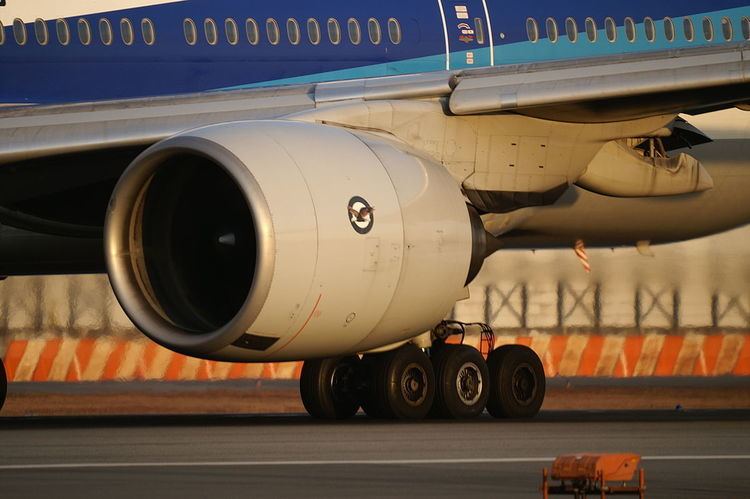 | ||
The Pratt & Whitney PW4000 is a family of high-bypass turbofan aircraft engines with certified thrust ranging from 52,000 to 99,040 lbf (230 to 441 kN). Built as the successor to the JT9D series engines, it has found much wider application than its predecessor.
Contents
Design and development
The PW4000 is divided into three distinct families based on fan diameter.
The first family is the 94 inch (2.4 m) diameter fan with certified thrust ranging from 52,000 to 62,000 lbf (230 to 275 kN). It powers the Airbus A310-300, A300-600 aircraft, Boeing 747-400, 767-200/300 and McDonnell Douglas MD-11 aircraft and is certified for 180-minute ETOPS if used in twinjets. These models include the PW4052, PW4056, PW4060, PW4062, PW4062A, PW4152, PW4156A, PW4156, PW4158, PW4460, and PW4462.
The second family is the 100 inch (2.5 m) diameter fan engine developed specifically for Airbus Industrie's A330 twinjet. It has certified thrust from 64,500 to 68,600 lbf (287 to 305 kN). Models are numbered PW4164, PW4168, and PW4168A. The launch of the Advantage70 program was announced at the 2006 Farnborough Airshow with a sale to Kingfisher Airlines. This package increases certified thrust to 70,000 lbf (311 kN,) reduces fuel burn by about 1%, and reduces maintenance costs by around 15%.
The third family is the 112 inch (2.8 m) diameter fan engine developed specifically for Boeing's 777 where it was the launch engine. It has certified thrust from 86,760 to 99,040 lbf (386 to 441 kN). Model numbers are PW4074, PW4077, PW4077D, PW4084, PW4084D, PW4090, and PW4098. It entered service on June 7, 1995, with United Airlines, and was the first jet engine to enter service with 180-minute ETOPS certification. It is an engine option for the 777-200, -200ER, and -300.
The PW4000 features advanced technology materials and Full Authority Digital Engine Control (FADEC), for enhanced fuel economy and reliability.
The engine feature the Technology for Advanced Low NOx (TALON) combustor.
PW4000-94
Thrust range: 231–276 kN (52,000 lbf – 62,000 lbf)
PW4000-100
Thrust range: 287–311 kN (64,500 lbf – 70,000 lbf)
PW4000-112
Thrust range: 329–436 kN (74,000 lbf – 98,000 lbf)
Applications
Specifications (PW4084)
Data from
